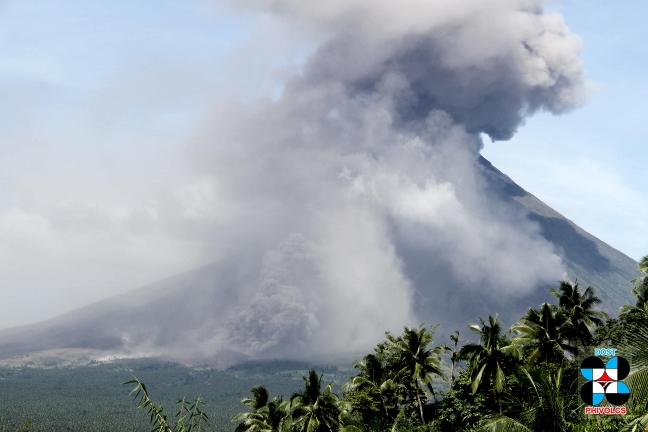ALBAY PROVINCE – The erupting Mayon Volcano blew twice during the daytime Tuesday, once at 11:50 a.m. and then again at 5:11 p.m., sending up huge columns of ash and grits that scattered and fell mostly on the towns of Camalig and Guinobatan.
Meanwhile, the Philippine Institute of Volcanology and Seismology (PHIVOLCS) sustained its public reminders to be watchful of possible lahar flows in the face of continuing intermittent rainy episodes.
The rain could soak up, loosen and mobilize pyroclastic deposits on the sloping flanks of the volcano into slurries of mud and sediment that race down the steep gullies and channels.
The state weather bureau, Philippine Atmospheric, Geophysical and Astronomical Services Administration (PAGASA), issued a forecast of cloudy skies and scattered rains for the 12-hour period starting 9:00 p.m. Tuesday.

A brief respite from the cloudiness Tuesday evening offered clear glimpses of the prevailing tantrums of the mountain of fire, its summit glowing red while shooting hisses of lava particles into the air above the crater.
Cascading crumbles of crawling lava peeled off the molten blobs that exited the mouth.
The extrusion of thick ash and smoke and steam alarmed a number of villagers within the danger zone in Guinobatan, who have so far been reluctant to heed the warnings of authorities to stay away, but were this time sufficiently moved to pack up and seek safer ground.
“Natatakot na po kami. Alis na kami (We are now afraid. We are moving out),” said Teresita Nantis, a child in tow. She told News5 that she came to prepare more things in their house for evacuation.

The powdery ash fall was so thick and somewhat acrid in the town of Camalig that residents were reporting almost zero visibility and breathing difficulty without dust masks.
But some particles were the size of pebbles and small stones, said Elmer Grageda, the village chief of Barangay Quirangay. “You could feel and hear the impact as they came down and landed.”
Still, there were some from Bgy Quirangay who politely chose to hang on and tough it out, instead of moving temporarily to evacuation centers “that are far from here and quite inconvenient.”
PHIVOLCS spokesman in Albay Paul Alanis explained that either of two scenarios are likely: One, that the molten material continues to gush out benignly in the form of lava flows and fountaining, or, two, internal pressure builds up overtaking the containment capacity of the crater dome, and thereby bursting in a cataclysmic explosive event.
In the meantime, the watchful observation and close monitoring continues.









